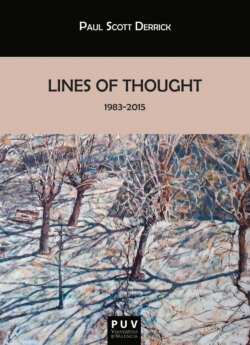Читать книгу Lines of Thought - Paul Scott Derrick Grisanti - Страница 10
На сайте Литреса книга снята с продажи.
ОглавлениеForeword
This book brings together twelve essays published during the span of years contained in its title: 1983-2015. To a certain extent, therefore, they reflect the evolution over more than three decades in my thinking about several of the authors that have maintained my interest and admiration for much of my life as a student, teacher and lover of literature.
I use the word “evolution” carefully, rather than the first word—“growth”—that came to mind as I wrote the previous sentence. For if you compare the earliest and most recent of the essays that follow you may conclude that my thinking has not grown at all. I do hope, though, that it might be perceived to have broadened and deepened.
The principal “line of thought” that unites this otherwise disparate collection of essays is the one that I had only vaguely begun to glimpse in my early and unending fascination with the poetry of Emily Dickinson. I didn’t see it when I wrote “Emily Dickinson, Martin Heidegger and the Poetry of Dread” because at that time I had not yet begun to study and ruminate on Emerson’s profound assimilation of romantic ideas for the benefit of the newly-emerging American character. I thought, then, that I had done enough in feeling out the unintended resonances between the amazing mind of a 19th-century American hermit-poet and a 20th-century German existential philosopher.
But as time went by, I gradually came to realize that I was describing what I now understand to be the central—albeit recessive—thread of American (and western) thought. It takes shape, from its European antecedents, in Emerson, passes through Thoreau, Whitman and Dickinson, doubles back to Europe in the thinking of Nietzsche and Heidegger and opens out in myriad forms through the 20th and 21st centuries, finding one of its most lucid contemporary expositors in Stanley Cavell.
Perhaps I should stress that I am not talking only about a linear series of causal influences, but a deeper general current of concepts and attitudes that underpin our culture and contribute to the way we formulate our images of what we are. It can be found, of course, in many more figures than those I name and discuss here.
It is true that the spiritual (i.e., non-materialistic) component of what we might think of as the original American aspiration was radically secularized over the course of the second half of the 19th century. As American life became more and more absorbed with both physical and economic expansion, the essentially romantic nature of our evolving character was pushed farther and farther into the background. But it did not disappear. It has always been there, most notably in the works of a large number of our finest artists. I am not alone in sustaining that the best American art is always subversive. That subversive thrust can take on many forms, but the main one is probably a resistance to the ever-growing power of materialistic values, in all of their various guises, in the life of the United States.
The aim of the first group of six essays that follows is to reflect on the central line of thought that I’ve referred to above, a line that passes from Emerson to Dickinson and leads on to Heidegger. I begin with an essay on Dickinson and Heidegger instead of Emerson simply because that early essay was my first, tentative step along this journey. Then come three essays on Emerson and two more recent ones on Dickinson. I hope that, taken together, they will make the ideational lineage I am trying to uncover more visible to the reader.
The next three essays follow some of the branches of that line in Sarah Orne Jewett, William S. Burroughs and Thomas Pynchon, and Timothy Steele. Whether they are conscious or not, echoes and reflections of Emerson’s and/or Heidegger’s thinking can be found in them all.
And the third section deals with a contemporary English poet—and friend—Richard Berengarten, whose work I deeply admire and believe to be a direct continuation of the inner core of thought in western culture that this book hopes to illuminate.
Do I need a further justification—beyond the Emerson-Dickinson-Heidegger-Cavell lineage that this collection traces—for grouping these particular writers and thinkers together? In the end, a faithful Emersonian, I can only appeal to my own self. These are the works that have sought out my sensibility, that have found a response in a mind, such as it is, that their calling out has helped to form.
What do we look for when we look for value in a work of art? Like Robert Frost, I think of questions that have no reply. Or so many very different replies that the questions are rendered moot. But Harold Bloom’s test seems good enough to me to work with: the poet and the poem should touch upon permanence. And how judge permanence? In Frostian terms, as inner and outer weather.
The majority of these writers and works are permanently installed in my own experience. I never tire of returning to them, and always find there something new and exciting. And if my responses to them are accurate, they will continue to be installed in the collective memory of the culture that we all construct together.
